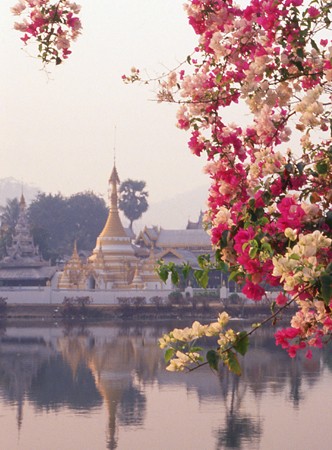Features on Asian Art, Culture, History & Travel
Archives
Archives > THAILAND > Bougainvillaea

Bougainvillaea
Saying It With Flowers: Chulalongkorn Day In Chiang Mai
SEE RELATED IMAGES @ PICTURES FROM HISTORY
Thai people everywhere respect and honour the memory of King Chulalongkorn, 5th monarch of the reigning Chakri Dynasty and father of modern Thailand. Foreigners and Thais alike agree that during his long reign - between October 1, 1868 and October 23, 1910 – King Chulalongkorn, also known as Rama V, skilfully directed Old Siam's transition to modern nationhood, whilst at the same time preserving the freedom, independence and dignity of the Thai people.
In Chiang Mai, the ancient capital of northern Thailand, the local people show their veneration for this beloved monarch by marking Chulalongkorn Day - October 23 - with a massive display of flowering Bougainvillaea at Thapae Gate, the eastern entrance to the Old City.
It seems entirely appropriate that King Chulalongkorn should be honoured in this way - through the brightly-coloured, paper-like flowers of the Bougainvillaea, a shrub so familiar that it is very much a part of the Thai landscape. And yet, appearances can be misleading. Though King Chulalongkorn would certainly have recognised many of the varieties of Bougainvillaea which flourish throughout Thailand today, Phra Narai, the 17th century ruler of Ayutthaya, would not have. For Bougainvillaea - known in Thai as feung fah, or "prosperous sky" - is a relative newcomer to Southeast Asia, a settler dating from the Age of Commerce when sailing vessels first plied the oceans of the world.
Named after Count Louis-Antoine De Bougainville (1729-1811), a distinguished French explorer and circumnavigator, the genus Bougainvillaea, including some 14 species of shrubs, vines and small trees, hails originally from South America. According to botanical studies, the purple-magenta blossoms originate mainly from Brazil, whilst the red-magenta is Andean, from Colombia and Peru. Yellow, orange and golden shades, too, are Andean, originating mainly in Peru.
First introduced to Europe by De Bougainville during the late 18th century, the feung fah shrub was later introduced to South and Southeast Asia by European merchantmen. Ideally suited for the warm, fertile climate of Thailand, the Bougainvillaea prospered and spread throughout the Kingdom. Today, in its many forms and varieties, it has become so intrinsically Thai - and indeed so popular with Thai people - that it is an ideal medium for celebrating the memory of a truly remarkable Thai monarch.
SEE MORE BOUGAINVILLAEA IMAGES @ PICTURES FROM HISTORY
Photos by Pictures From History - © CPA Media
